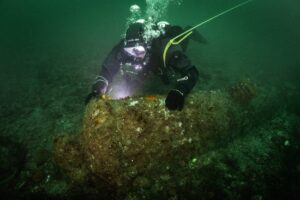The Wildlife Photographer of the Year is regarded universally as the pinnacle of nature photography competitions. It is arguably the most famous photo contest in the world. This year’s competition attracted a record 50,000 entries and is the only one that all the very best underwater photographers enter to be judged against all their peers. Of course, when you do get picked, the success can be life changing. Not only is the ‘black tie’ award ceremony at London’s Natural History Museum seemingly straight out of a fairytale, but the winning images are seen by 100s of millions of people in media, books and exhibits all around the world for years and years. Your photo and subject become very famous indeed.
This year’s competition has just announced its results and I am delighted to have been awarded! My photo of a ghost pipefish hiding inside a crinoid was taken in Dauin in the Philippines, while staying at the Atlantis Resort. I am also really excited because this year has more underwater photos awarded than ever before, reflecting the real shift in society’s interest in the oceans and looking after the wildlife there. Some of the most celebrated underwater photographers around, like Laurent Ballesta and David Doubilet were winners too. You can browse through all the winners here.
To be successful in any competition that attracts 50,000 images, you need to stand out from the crowd. For this image I used a vintage lens, made about 70 years ago, attached to my very modern Nikon D850 camera. Now, I am not claiming that this is the equipment that all underwater photographers need to use from now on, but for this image it was perfect. These old, simple lenses are not as sharp as modern lenses, but they are sometimes used for portraits on land because of the way they give the out of focus elements of the picture a dreamy look. I wanted to try this underwater. It also meant creating a gear for focusing the lens through my Subal housing, and fitting the lens with sunglasses (ND8 filter), so it didn’t over expose when I was taking photos with the aperture fully open.
Photographers are always interested in understanding why a picture is successful when there are so many good ones in a contest, so I will add some comments on why I think my picture won (although I have not discussed it with the judges)…
First, despite my picture being taken with an unusual technique, the judges knew nothing about the technique or equipment when judging it. In fact, vintage lenses don’t leave a trace in the camera’s image information for them to check! But I am sure that the judges responded to the fact that the photo looks very different to other normal underwater photos. As I said before, standing out and innovating are always good in competitions of 50,000 photos. I think the most important thing is that the technique/equipment choices are properly aligned with the story that I was trying to tell about the subject. The photo technique supports the camouflage/hiding narrative of the picture.
Like many winning pictures, the photo was also a long time coming. I have been shooting this lens underwater for 8 years and I have evolved how I am using it over time. Initiall,y my photos with this lens were of any subject and then the most impressive background effect I could create. These were eye-catching photos, but not winners in a wildlife contest. These were pictures all about me, not the subject. Other photographers liked them because they could see I was being clever with technique, but the wildlife was just a subject, the photo was saying lots about me and nothing about nature. In this picture the effect of the lens is much more subtle, and is there to enhance the wildlife story.
Like all winning photos, the image also needs some luck. First, shooting with a blurry vintage lens underwater is tricky. At f/2.8 there is very little depth of field, the subject is moving, the background is moving, I am moving and the lens is manual focus. As with all contests you need the luck that the judges went with your photo on that day (or 4 weeks as it took them to judge this competition).
The post Wildlife Photographer of the Year appeared first on Mares – Scuba Diving Blog.
Read MoreDiving, diving, ocean, photography, underwaterMares – Scuba Diving Blog

